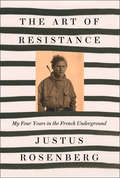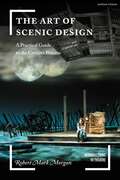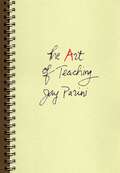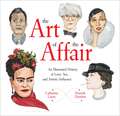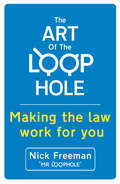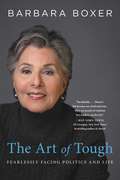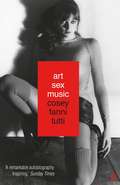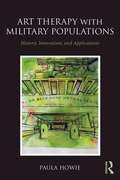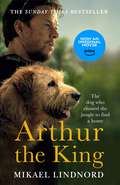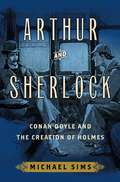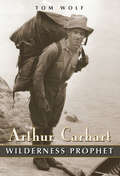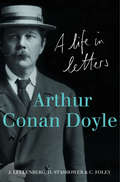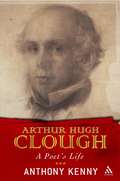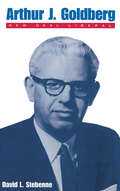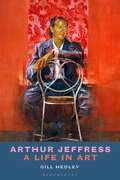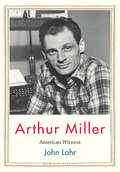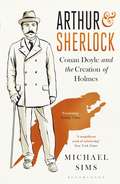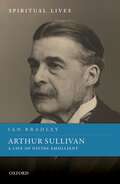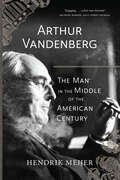- Table View
- List View
The Art of Resistance: My Four Years In The French Underground: A Memoir
by Justus RosenbergA gripping memoir written by a 96-year-old Jewish Holocaust survivor about his escape from Nazi-occupied Poland in the 1930's and his adventures with the French Resistance during World War II
The Art of Scenic Design: A Practical Guide to the Creative Process (Introductions to Theatre)
by Robert Mark MorganHow do you navigate a career as an entertainment designer while maintaining a sense of self-worth and value in the various off-ramps and sidestreets you may choose to take on the journey? The Art of Scenic Design provides an in-depth look at the scenic design process for young designers as well as creative entrepreneurs seeking to nurture a collaborative environment that leads to rediscovery and innovation in their work. Based on his 30 years of experience in stage design, exhibit design, art direction for film, and theme park and industrial design, Robert Mark Morgan demonstrates that while a design process for creating these types of works can seem like niche professions, the lessons learned in collaboration, testing and re-testing ideas, prototyping concepts, overcoming fears, venturing guesses, divergent thinking, and the creative process in general are applicable – and valuable – in nearly all disciplines and professions both inside and outside of the entertainment industry.In The Art of Scenic Design: A Practical Guide to the Creative Process you will follow an accomplished designer on a narrative of the theatrical design process from early phases of a design with a creative team encompassing visual research, idea-making, and collaborative relationships, to sketching, prototyping, and testing ideas, through to the execution and manifestation of the design with a team of artists and collaborators. The design journey is contextualized with backstage stories of "what if?" moments, provocative discussions, and lessons that are indispensable to your professional development.
The Art of Scenic Design: A Practical Guide to the Creative Process (Introductions to Theatre)
by Robert Mark MorganHow do you navigate a career as an entertainment designer while maintaining a sense of self-worth and value in the various off-ramps and sidestreets you may choose to take on the journey? The Art of Scenic Design provides an in-depth look at the scenic design process for young designers as well as creative entrepreneurs seeking to nurture a collaborative environment that leads to rediscovery and innovation in their work. Based on his 30 years of experience in stage design, exhibit design, art direction for film, and theme park and industrial design, Robert Mark Morgan demonstrates that while a design process for creating these types of works can seem like niche professions, the lessons learned in collaboration, testing and re-testing ideas, prototyping concepts, overcoming fears, venturing guesses, divergent thinking, and the creative process in general are applicable – and valuable – in nearly all disciplines and professions both inside and outside of the entertainment industry.In The Art of Scenic Design: A Practical Guide to the Creative Process you will follow an accomplished designer on a narrative of the theatrical design process from early phases of a design with a creative team encompassing visual research, idea-making, and collaborative relationships, to sketching, prototyping, and testing ideas, through to the execution and manifestation of the design with a team of artists and collaborators. The design journey is contextualized with backstage stories of "what if?" moments, provocative discussions, and lessons that are indispensable to your professional development.
The Art of Teaching
by Jay PariniBecoming an effective teacher can be quite painful and exhausting, taking years of trial and error. In The Art of Teaching, writer and critic Jay Parini looks back over his own decades of trials, errors, and triumphs, in an intimate memoir that brims with humor, encouragement, and hard-won wisdom about the teacher's craft. Here is a godsend for instructors of all levels, offering valuable insight into the many challenges that educators face, from establishing a persona in the classroom, to fostering relationships with students, to balancing teaching load with academic writing and research. Insight abounds. Parini shows, for instance, that there is nothing natural about teaching. The classroom is a form of theater, and the teacher must play various roles. A good teacher may look natural, but that's the product of endless practice. The book also considers such topics as the manner of dress that teachers adopt (and what this says about them as teachers), the delicate question of politics in the classroom, the untapped value of emeritus professors, and the vital importance of a settled, disciplined life for a teacher and a writer. Parini grounds all of this in personal stories of his own career in the academy, tracing his path from unfocused student--a self-confessed "tough nut to crack"--to passionate writer, scholar, and teacher, one who frankly admits making many mistakes over the years. Every year, thousands of newly minted college teachers embark on their careers, most with scant training in their chosen profession. The Art of Teaching is a perfect book for these young educators as well as anyone who wants to learn more about this difficult but rewarding profession.
The Art of the Affair: An Illustrated History of Love, Sex, and Artistic Influence
by Catherine Lacey Forsyth HarmonA vibrantly illustrated chain of entanglements (romantic and otherwise) between some of our best-loved writers and artists of the twentieth century--fascinating, scandalous, and surprising. Poet Robert Lowell died of a heart attack, clutching a portrait of his lover, Caroline Blackwood, painted by her ex-husband, Lucian Freud. Lowell was on his way to see his own ex-wife, Elizabeth Hardwick, who was a longtime friend of Mary McCarthy. McCarthy left the father of her child to marry Edmund Wilson, who had encouraged her writing, and had also brought critical attention to the fiction of Anaïs Nin . . . whom he later bedded. And so it goes, the long chain of love, affections, and artistic influences among writers, musicians, and artists that weaves its way through the The Art of the Affair--from Frida Kahlo to Colette to Hemingway to Dali; from Coco Chanel to Stravinsky to Miles Davis to Orson Welles.Scrupulously researched but playfully prurient, cleverly designed and colorfully illustrated, it's the perfect gift for your literary lover--and the perfect read for any good-natured gossip-monger.
The Art of the Loophole: David Beckham's lawyer teaches you how to make the law work for you
by Nick FreemanCelebrity lawyer Mr Loophole. Nick Freeman is Britain`s highest profile lawyer. He has won cases for David Beckham and many other celebrities, and attracts more media attention than any other lawyer in the country. Not just for the rich and famous, you can use his lessons to make sure that the law works for you. Learn every trick in the book from the man who's defended the greats. Mr Loophole is famous for forming winning, quirky and innovative defences - even when a case appears indefensible. In the process, he has revolutionised the way in which law - particularly motoring law - is practised. In this book, Nick explains his unique approach to the law and in the process identifies his killer loophole principles
The Art of Tough: Fearlessly Facing Politics and Life
by Barbara Boxer"One goal of this memoir is to inspire people to fight for change. It takes what I call the Art of Tough and I've had to do it all my life." -- Senator Barbara Boxer Barbara Boxer has made her mark, combining compassionate advocacy with scrappiness in a political career spanning more than three decades. Now, retiring from the Senate, she continues the work to which she's dedicated 30 years in Congress. Her memoir, The Art of Tough, shares her provocative and touching recollections of service, and cements her commitment to the fight for women, families, quality, environmental protection, all in a peaceful world. Sometimes lauded, sometimes vilified, but always standing tough, Boxer has fought for what is right even when her personal convictions conflicted with her party or the majority rule.
Art Sex Music (Faber Greatest Hits Ser.)
by Cosey Fanni TuttiA SUNDAY TIMES, TELEGRAPH, ROUGH TRADE, PITCHFORK AND UNCUT MUSIC BOOK OF THE YEARSHORTLISTED FOR THE PENDERYN MUSIC BOOK PRIZEArt Sex Music is the autobiography of a musician who, as a founding member of the avant-garde group Throbbing Gristle and electronic pioneers Chris & Cosey, has consistently challenged the boundaries of music over the past four decades.It is the account of an artist who, as part of COUM Transmissions, represented Britain at the IXth Biennale de Paris, whose Prostitution show at the ICA in 1976 caused the Conservative MP Nicholas Fairbairn to declare her, COUM and Throbbing Gristle 'Wreckers of Civilisation' . . . shortly before he was arrested for indecent exposure, and whose work continues to be held at the vanguard of contemporary art.And it is the story of her work as a pornographic model and striptease artiste which challenged assumptions about morality, erotica and art.Art Sex Music is the wise, shocking and elegant autobiography of Cosey Fanni Tutti.
Art Therapy With Military Populations: History, Innovation, And Applications
by Paula HowieFor decades, art therapy has proved to be a practical treatment for veterans and other military populations suffering from trauma. Art Therapy with Military Populations provides an in-depth overview of both the theoretical and historical bases of art therapy with these groups while also chronicling the latest trends in treatment and the continued expansion of treatment settings. Edited by an art therapist with over 25 years’ experience working with the military and including chapters by a variety of seasoned and innovative clinicians, this comprehensive new volume provides professionals with cutting edge knowledge and interventions for working with military service members and their families. Available for download are employment resources for art therapists who would like to work in military settings, a bonus chapter, historical documents on establishing art therapy, a treatment objectives manual, and resources for art therapists.
Art Therapy With Military Populations (PDF): History, Innovation, And Applications
by Paula HowieFor decades, art therapy has proved to be a practical treatment for veterans and other military populations suffering from trauma. Art Therapy with Military Populations provides an in-depth overview of both the theoretical and historical bases of art therapy with these groups while also chronicling the latest trends in treatment and the continued expansion of treatment settings. Edited by an art therapist with over 25 years’ experience working with the military and including chapters by a variety of seasoned and innovative clinicians, this comprehensive new volume provides professionals with cutting edge knowledge and interventions for working with military service members and their families. Available for download are employment resources for art therapists who would like to work in military settings, a bonus chapter, historical documents on establishing art therapy, a treatment objectives manual, and resources for art therapists.
Arthur: The dog who crossed the jungle to find a home
by Mikael LindnordTHE SUNDAY TIMES BESTSELLERWhen you are racing 435 miles through the jungles and mountains of South America, the last thing you need is a stray dog tagging along. But that's exactly what happened to Mikael Lindnord, captain of a Swedish adventure racing team, when he threw a scruffy but dignified mongrel a meatball one afternoon. When they left the next day, the dog followed. Try as they might, they couldn't lose him - and soon Mikael realised that he didn't want to. Crossing rivers, battling illness and injury, and struggling through some of the toughest terrain on the planet, the team and the dog walked together towards the finish line, where Mikael decided he would save Arthur and bring him back to his family in Sweden, whatever it took.Reactions to Arthur's story:'an incredible journey' Daily Telegraph'Arthur latched onto an extreme sports team during the Amazon race - and what happened next will melt the hardest heart' - Daily Mail
Arthur and Sherlock: Conan Doyle and the Creation of Holmes
by Michael Sims2018 Edgar Award NomineeShortlisted for the H. R. F. Keating Award from the International Crime Writers AssociationFrom Michael Sims, the acclaimed author of The Story of Charlotte's Web, the rich, true tale tracing the young Arthur Conan Doyle's creation of Sherlock Holmes and the modern detective story.As a young medical student, Arthur Conan Doyle studied in Edinburgh under the vigilant eye of a diagnostic genius, Dr. Joseph Bell. Doyle often observed Bell identifying a patient's occupation, hometown, and ailments from the smallest details of dress, gait, and speech. Although Doyle was training to be a surgeon, he was meanwhile cultivating essential knowledge that would feed his literary dreams and help him develop the most iconic detective in fiction. Michael Sims traces the circuitous development of Conan Doyle as the father of the modern mystery, from his early days in Edinburgh surrounded by poverty and violence, through his escape to University (where he gained terrifying firsthand knowledge of poisons), leading to his own medical practice in 1882. Five hardworking years later--after Doyle's only modest success in both medicine and literature--Sherlock Holmes emerged in A Study in Scarlet. Sims deftly shows Holmes to be a product of Doyle's varied adventures in his personal and professional life, as well as built out of the traditions of Edgar Allan Poe, Émile Gaboriau, Wilkie Collins, and Charles Dickens--not just a skillful translator of clues, but a veritable superhero of the mind in the tradition of Doyle's esteemed teacher. Filled with details that will surprise even the most knowledgeable Sherlockian, Arthur and Sherlock is a literary genesis story for detective fans everywhere.
Arthur Carhart: Wilderness Prophet
by Tom WolfArthur Carhart (1892 -1978), America's first champion of wilderness, the first Forest Service landscape architect, and the most popular conservation writer of mid-century America, won none of the titan status of his contemporary Aldo Leopold. A political maverick, he refused to side with any major advocacy group and none has made him its saint. Carhart was a grassroots thinker in a top-down era. Arthur Carhart, the first biography of this Republican environmentalist and major American thinker, writer, and activist, reveals the currency of his ideas. Tom Wolf elucidates Carhart 's vision of conservation as "a job for all of us," with citizens, municipal authorities, and national leaders all responsible for the environmental effects of their decisions. Carhart loved the local and decried interest groups - from stockmens' associations to wilderness lobbies - as cliques attempting blanket control. He pressured land management agencies to base decisions on local ecology and local partnerships. A lifelong wilderness advocate who proposed the first wilderness preserve at Trappers Lake, Colorado, in 1919, Carhart chose to oppose the Wilderness Act, heartsick at its compromises with lobbies. Because he shifted his stance and changed his views in response to new information, Carhart is not an easy subject for a biography. Wolf traces Carhart's twists and turns to show a man whose voice was distinctive and contrary, who spoke from a passionate concern for the land and couldn't be counted on for anything else. Readers of American history and outdoor writing will enjoy this portrait of a historic era in conservation politics and the man who so often eschewed politics in favor of the land and people he loved.
Arthur Conan Doyle: A Life In Letters
by Arthur Conan DoyleA collection of letters between Arthur Conan Doyle (author and creator of Sherlock Holmes) and his mother, covering most of his life, written between 1867 and the year of her death in 1921.
Arthur Hugh Clough: A Poet's Life
by Anthony KennyArthur Hugh Clough (1819-1861) is one of the great undiscovered geniuses of Victorian literature. His poetry expresses the religious doubt of the age as well as exposing its sexual hypocrisy. His life is packed full of relationships and encounters with some of the great names of the 19th century; Florence Nightingale, Thomas Carlyle, Ralph Waldo Emerson, Cardinal Newman, Tennyson, the Arnolds and so on. Clough's early death at the age of 42, worn down, it is said, by working as a factotum for Nightingale, was widely seen as a personal tragedy of unfulfilled promise. Now Kenny, the distinguished philosopher and former Master of Balliol College, Oxford, proposes to write three first major biography of Clough in thirty years. It is a task that has attracted others- Claire Tomalin for example- but Kenny is supremely qualified to do so. Not only is he already the editor of Clough's diaries, he has unrivalled insights into the world that contributed to Clough's tortured existence and has a lifelong knowledge of Clough's work. Additionally, Kenny has access to letters and other papers at Balliol, which have never been used by any biographer. In Kenny's biography, Clough will be re-established as one of the great Victorian poets (a judgement shared by Christopher Ricks in his 1987 Oxford Book of Victorian Verse) and also a significant personality of the Victorian stage.
Arthur J. Goldberg: New Deal Liberal
by David StebenneThis book is the first biography ever written of Arthur J. Goldberg, the former labor lawyer, Secretary of Labor under Kennedy, and Supreme Court justice (which post he resigned at the request of Lyndon Johnson to become U.S. Ambassador to the United Nations), who played a leading role in American political life from World War II until the end of the 1960s. Goldberg, who never wrote memoirs himself, shared his thoughts about his life and work with Stebenne in a series of conversations, which took place occasionally from the fall of 1981 through to Goldberg's death in 1990. He also allowed Stebenne access to his papers, including those held under seal in presidential libraries and at the Library of Congress. Based upon these unique sources and written to be accessible to a wide audience, Arthur J. Goldberg is both the story of a leading American liberal and a history of modern American liberalism.
Arthur Jeffress: A Life in Art
by Gill HedleyArthur Jeffress was an art dealer and collector from a Virginian family who bequeathed his “subversive little collection” (Derek Hill) to Tate and Southampton City Art Gallery on his suicide in 1961. That suicide, a result of his expulsion from Venice, has been the subject of speculation in many memoirs.Gill Hedley's biography of Jeffress has benefited from access to many hundreds of unpublished letters written between Jeffress and Robert Melville, who ran Jeffress' own gallery from 1955-1961. The letters were written largely while Jeffress was in Venice and reveal a vivid picture of the London gallery world as well as frank details of artists, collectors and the definitive story of his suicide.Previously unpublished research reveals new information about the lives of Jeffress' lover John Deakin, his business partner Erica Brausen, the French photographer André Ostier and Henry Clifford, and the way in which all of them influenced Jeffress' first steps as a collector from the 1930s onwards.
Arthur Jeffress: A Life in Art
by Gill HedleyArthur Jeffress was an art dealer and collector from a Virginian family who bequeathed his “subversive little collection” (Derek Hill) to Tate and Southampton City Art Gallery on his suicide in 1961. That suicide, a result of his expulsion from Venice, has been the subject of speculation in many memoirs.Gill Hedley's biography of Jeffress has benefited from access to many hundreds of unpublished letters written between Jeffress and Robert Melville, who ran Jeffress' own gallery from 1955-1961. The letters were written largely while Jeffress was in Venice and reveal a vivid picture of the London gallery world as well as frank details of artists, collectors and the definitive story of his suicide.Previously unpublished research reveals new information about the lives of Jeffress' lover John Deakin, his business partner Erica Brausen, the French photographer André Ostier and Henry Clifford, and the way in which all of them influenced Jeffress' first steps as a collector from the 1930s onwards.
Arthur Miller: American Witness (Jewish Lives)
by John LahrA great theater critic brings twentieth-century playwright Arthur Miller’s dramatic story to life with bold and revealing new insights “New Yorker critic Lahr shines in this searching account of the life of playwright Arthur Miller. . . . It’s a great introduction to a giant of American letters.”—Publishers Weekly Distinguished theater critic John Lahr brings unique perspective to the life of Arthur Miller (1915–2005), the playwright who almost single-handedly propelled twentieth-century American theater into a new level of cultural sophistication. Organized around the fault lines of Miller’s life—his family, the Great Depression, the rise of fascism, Elia Kazan and the House Committee on Un-American Activities, Marilyn Monroe, Vietnam, and the rise and fall of Miller’s role as a public intellectual—this book demonstrates the synergy between Arthur Miller’s psychology and his plays. Concentrating largely on Miller’s most prolific decades of the 1940s, 1950s, and 1960s, Lahr probes Miller’s early playwriting failures; his work writing radio plays during World War II after being rejected for military service; his only novel, Focus; and his succession of award-winning and canonical plays that include All My Sons, Death of a Salesman, and The Crucible, providing an original interpretation of Miller’s work and his personality.
Arthur & Sherlock: Conan Doyle and the Creation of Holmes
by Michael Sims'Fascinating … A stimulating contribution to our never-ending fascination with Holmes himself, and, even more perhaps, his genial creator' Sunday TimesA medical student at the University of Edinburgh, Arthur Conan Doyle studied under the vigilant eye of Dr Joseph Bell. He observed as Dr Bell identified a patient's occupation, hometown and ailments from the smallest details of dress, gait and speech. Although Doyle was training to be a surgeon, he was cultivating essential knowledge that would help him to define the art of the detective novel. From Doyle's early days surrounded by poverty and violence, through to his first days as a surgeon, Michael Sims traces the circuitous yet inevitable development of Arthur Conan Doyle as the father of the modern mystery. The incomparable Sherlock Holmes emerges as a product of Doyle's varied lessons in the classroom and professional life.
Arthur Sullivan: A Life of Divine Emollient (Spiritual Lives)
by Ian BradleyThis book charts the life of Arthur Sullivan—the best loved and most widely performed British composer in history. While he is best known for his comic opera collaborations with W. S. Gilbert, it was his substantial corpus of sacred music which meant most to him and for which he wanted to be remembered. His upbringing and training in church music, and his own religious beliefs, substantially affected both his compositions for the theatre and his more serious work, which included oratorios, cantatas, sacred ballads, liturgical pieces, and hymns. Focusing on the spiritual aspects of Sullivan's life—which included several years as a church organist, involvement in Freemasonry, and an undying attachment to Anglican church music—Ian Bradley uses hitherto undiscovered letters, diary entries, and other sources to reveal the important influences on his faith and his work. No saint and certainly no ascetic, he was a lover of life and enjoyed its pleasures to the full. At the same time, he had a rare spiritual sensitivity, a sincere Christian faith, and a unique ability to uplift through both his character and his music that can best be described as a quality of divine emollient.
Arthur Sullivan: A Life of Divine Emollient (Spiritual Lives)
by Ian BradleyThis book charts the life of Arthur Sullivan—the best loved and most widely performed British composer in history. While he is best known for his comic opera collaborations with W. S. Gilbert, it was his substantial corpus of sacred music which meant most to him and for which he wanted to be remembered. His upbringing and training in church music, and his own religious beliefs, substantially affected both his compositions for the theatre and his more serious work, which included oratorios, cantatas, sacred ballads, liturgical pieces, and hymns. Focusing on the spiritual aspects of Sullivan's life—which included several years as a church organist, involvement in Freemasonry, and an undying attachment to Anglican church music—Ian Bradley uses hitherto undiscovered letters, diary entries, and other sources to reveal the important influences on his faith and his work. No saint and certainly no ascetic, he was a lover of life and enjoyed its pleasures to the full. At the same time, he had a rare spiritual sensitivity, a sincere Christian faith, and a unique ability to uplift through both his character and his music that can best be described as a quality of divine emollient.
Arthur Szyk: Artist, Jew, Pole (The Littman Library of Jewish Civilization)
by Joseph P. AnsellArtist and illustrator Arthur Szyk was a Polish Jew whose work was overwhelmingly Jewish in theme and content. In a lifetime of creativity that spanned many of the major events of the twentieth century and took him from Poland to France, England, and the United States, the mission he set himself was to use his artistic talents to serve humanity and the Jewish people. Though his politics were dictated by what he thought would be good for the Jews, his work as a political artist went well beyond a narrow definition of the Jewish cause. He is best known among Jews for his illustrated Haggadah, but the overwhelming majority of his work deals with contemporary political themes and social causes. In his native Poland, Szyk promoted the causes of freedom, toleration, and human dignity, drawing his inspiration from the Old Testament. He believed that as a Jewish artist he had a responsibility to speak for all minorities. His famous illustration of the historical Statute of Kalisz symbolized his belief that the newly re-established Polish state would welcome all its citizens into full and equal participation. Even though at that time he was already based outside Poland, he worked for many years on behalf of the Polish government in an effort to strengthen the Jews’ position. Szyk left Europe in 1940 and arrived in the United States via Canada later the same year. Determined as ever to use his art for political purposes, he crusaded against the Nazis through newspaper and magazine cartoons, posters and public exhibitions. Convinced that Hitler would not stop with the Jews but would suppress all freedom-loving people, he supported the war effort through his striking propaganda images of the German and Japanese armies, to great effect. After the war he turned his efforts to promoting the idea of a Jewish homeland in Israel. In every phase of his career, one finds Szyk looking to the past but hoping for the future; he believed that art could make a difference in the world, politically and socially. Joseph Ansell’s biography makes a singular contribution to the history of Jewish art and of Polish-Jewish relations in the first half of the twentieth century.
Arthur Vandenberg: The Man in the Middle of the American Century
by Hendrik MeijerThe idea that a Senator—Republican or Democrat—would put the greater good of the country ahead of party seems nearly impossible to imagine in our current climate of gridlock and divisiveness. But this hasn’t always been the case. Arthur H. Vandenberg (1884–1951), Republican from Grand Rapids, Michigan, was the model of a consensus builder, and the coalitions he spearheaded continue to form the foundation of American foreign and domestic policy today. Edward R. Murrow called him “the central pivot of the entire era,” yet, despite his significance, Vandenberg has never received the full public attention he is due—until now. With this authoritative biography, Hendrik Meijer reveals how Vandenberg built and nurtured the bipartisan consensus that created the American Century. Originally the editor and publisher of the Grand Rapids Herald, Vandenberg was appointed and later elected to the Senate in 1928, where he became an outspoken opponent of the New Deal and a leader among the isolationists who resisted FDR’s efforts to aid European allies at the onset of World War II. But Vandenberg soon recognized the need for unity at the dawn of a new world order; and as a Republican leader, he worked closely with Democratic administrations to build the strong bipartisan consensus that established the Marshall Plan, the United Nations, and NATO. Vandenberg, as Meijer reveals, was instrumental in organizing Congressional support for these monumental twentieth-century foreign policy decisions. Vandenberg’s life and career offer powerful lessons for today, and Meijer has given us a story that suggests an antidote to our current democratic challenges. After reading this poignant biography, many will ask: Where is the Vandenberg of today?
Arthur Vandenberg: The Man in the Middle of the American Century
by Hendrik MeijerThe idea that a Senator—Republican or Democrat—would put the greater good of the country ahead of party seems nearly impossible to imagine in our current climate of gridlock and divisiveness. But this hasn’t always been the case. Arthur H. Vandenberg (1884–1951), Republican from Grand Rapids, Michigan, was the model of a consensus builder, and the coalitions he spearheaded continue to form the foundation of American foreign and domestic policy today. Edward R. Murrow called him “the central pivot of the entire era,” yet, despite his significance, Vandenberg has never received the full public attention he is due—until now. With this authoritative biography, Hendrik Meijer reveals how Vandenberg built and nurtured the bipartisan consensus that created the American Century. Originally the editor and publisher of the Grand Rapids Herald, Vandenberg was appointed and later elected to the Senate in 1928, where he became an outspoken opponent of the New Deal and a leader among the isolationists who resisted FDR’s efforts to aid European allies at the onset of World War II. But Vandenberg soon recognized the need for unity at the dawn of a new world order; and as a Republican leader, he worked closely with Democratic administrations to build the strong bipartisan consensus that established the Marshall Plan, the United Nations, and NATO. Vandenberg, as Meijer reveals, was instrumental in organizing Congressional support for these monumental twentieth-century foreign policy decisions. Vandenberg’s life and career offer powerful lessons for today, and Meijer has given us a story that suggests an antidote to our current democratic challenges. After reading this poignant biography, many will ask: Where is the Vandenberg of today?
